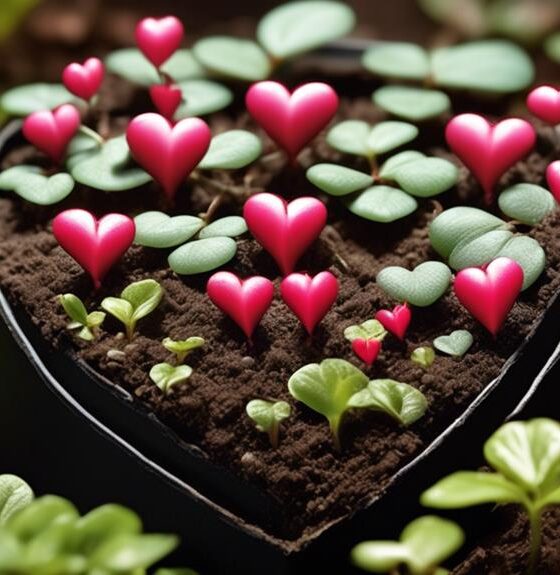Plants
Kalanchoe Care: Cultivating Vibrant Plants

Welcome to our blog post on kalanchoe, a popular and versatile plant that adds a vibrant touch to any indoor or outdoor space with its colorful flowers that bloom and flower buds. With its stunning colorful flowers and succulent leaves, kalanchoe is known for its beauty and resilience. This indoor plant produces beautiful flower buds and thrives in a clay pot.
Within the genus Kalanchoe, there are over 100 unique species of indoor plants, each with its own distinct characteristics. These plants are known for their flower buds and ability to bloom in various climates. Whether you’re a beginner or an experienced gardener, kalanchoe is the perfect choice to enhance your surroundings. With its vibrant blooms and ability to thrive in various climates, kalanchoe is a great addition to any garden. It is particularly known for its resilience against powdery mildew, making it an ideal plant for the spring season.
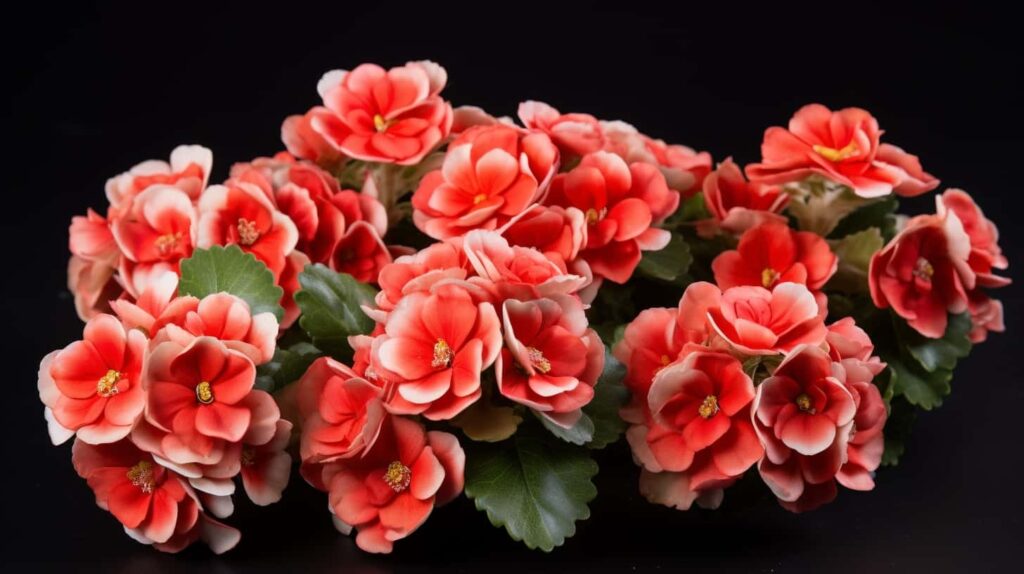
From finding the ideal environment and container to placing the kalanchoe beharensis near a sunny south-facing window, we’ll guide you through every step of the process.
So let’s dive in and discover all there is to know about the kalanchoe genus!
Discovering Kalanchoe
Kalanchoe plants have captured the hearts of gardeners all over the world, thanks to their stunning beauty and easy care. These plants originate from Madagascar but have quickly gained popularity worldwide due to their unique characteristics. Introduced to Europe in the 19th century, kalanchoe became an instant favorite among garden enthusiasts. Since then, it has been widely cultivated as both a houseplant and a garden ornamental in many countries.
The genus Kalanchoe boasts a diverse range of species, each with its own distinct growth habits, leaf shapes, and flower colors. Some popular species include Kalanchoe blossfeldiana, Kalanchoe pinnata, and Kalanchoe daigremontiana. With such variety available, there is a kalanchoe plant to suit every preference and gardening style. Whether you are looking for medicinal properties or simply want an eye-catching addition to your garden or home decor, kalanchoe has got you covered.
One of the standout features of kalanchoe plants is their long-lasting blooms that can brighten up any space. Most kalanchoe species bloom during the winter months when other plants may be dormant. The blooming period can vary from several weeks to several months depending on the specific species and environmental conditions. By providing proper care and maintenance, you can encourage more frequent and abundant blooms from your kalanchoe plants.

You have the option of keeping them indoors or planting them outdoors based on your climate and personal preference. Indoor kalanchoes thrive in bright but indirect light conditions with moderate temperatures. They make excellent additions to windowsills or well-lit areas within your home. On the other hand, outdoor kalanchoes prefer full sun or partial shade along with well-draining soil for optimal growth.
If you decide to keep your kalanchoe indoors, make sure to place it in a location that receives plenty of natural light. A south-facing window or an area with bright, indirect light is ideal. Avoid placing it near drafty windows or areas with extreme temperature fluctuations. As for watering, kalanchoes prefer to dry out between waterings, so be careful not to overwater them. Allow the top inch of soil to dry before watering again.
For those who choose to plant their kalanchoe outdoors, ensure that the soil is well-draining and enriched with organic matter. It’s important to note that while kalanchoes can tolerate drought conditions, they still require regular watering during hot and dry spells. Adding a layer of mulch around the base of the plant can help retain moisture and regulate soil temperatures.
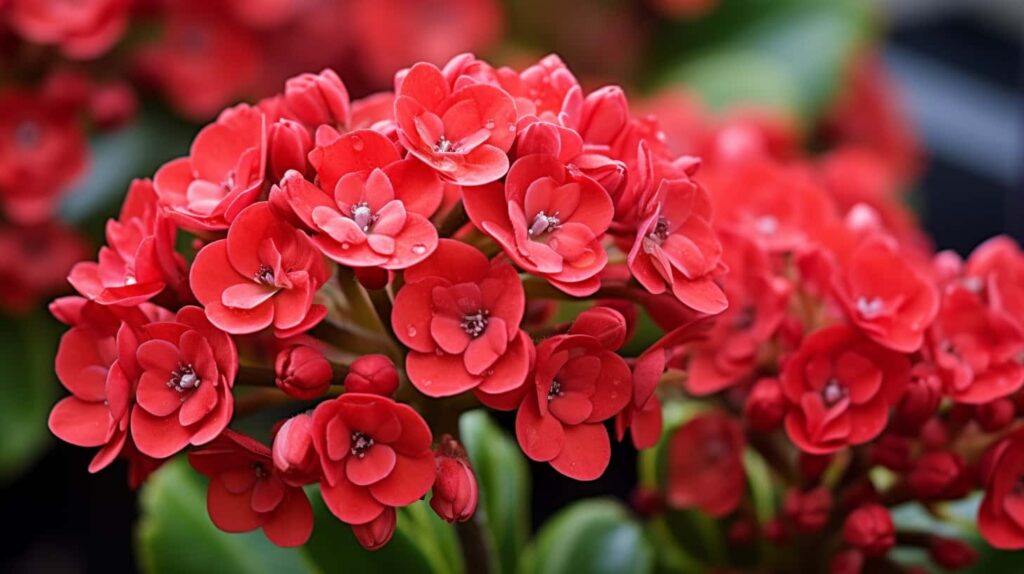
Cultivating Kalanchoe Blossfeldiana
Cultivating kalanchoe blossfeldiana, also known as flaming Katy, is a rewarding experience that allows us to enjoy the vibrant and long-lasting blooms of this beautiful succulent plant. To ensure successful growth and blooming, we need to pay attention to several key factors such as planting basics, soil selection, and lighting needs.
Planting Basics
Selecting the right pot or container is crucial for its overall health. We should choose a container with drainage holes to prevent waterlogging, as excessive moisture can lead to root rot. Using a well-draining potting mix specifically formulated for succulent plants will provide the ideal growing conditions for our kalanchoe.
To transplant our kalanchoe into its new home, we gently remove the plant from its nursery pot and place it in the prepared container. It’s important to ensure that the roots are covered with soil while being careful not to bury the stem too deeply. After planting, we should water thoroughly and then allow the soil to dry out slightly between waterings. This watering regimen helps prevent overwatering and promotes healthy root development.
Soil Selection
Choosing the right soil mix is essential for the successful cultivation of kalanchoe blossfeldiana. These plants prefer a well-draining soil that mimics their natural habitat. A combination of regular potting soil, perlite, and sand creates an ideal growing medium for our kalanchoe.
Regularly checking the moisture levels of the soil is crucial in maintaining optimal growing conditions for our kalanchoe. Heavy soils that retain moisture for extended periods can lead to root rot, so we must adjust our watering accordingly based on these observations.

Lighting Needs
Proper lighting is vital for the healthy growth and flowering of our kalanchoe blossfeldiana. These plants thrive in bright, indirect light but can tolerate some direct sunlight. Placing indoor kalanchoe near a south-facing window or providing supplemental grow lights if natural light is limited will ensure they receive adequate illumination.
For those who choose to cultivate their kalanchoe outdoors, it’s important to select a planting location that receives at least six hours of sunlight per day. This exposure to sunlight promotes robust growth and abundant flowering. However, we need to monitor our plant for signs of sunburn or insufficient light exposure, such as leggy growth or pale leaves. Adjusting the positioning of our kalanchoe accordingly can help mitigate these issues.
Propagating Kalanchoe Plants
Propagating kalanchoe plants is an exciting way to expand your plant collection or share the beauty of these succulents with others. There are several methods you can use to propagate kalanchoe, including leaf cuttings, offshoots, and seed sowing. Each method has its own unique process and requirements, so let’s explore them in more detail.
Leaf Cuttings
Leaf cuttings are a popular and effective way to propagate kalanchoe plants. To start, select a healthy leaf from the parent plant, making sure to include the petiole (the stem that attaches the leaf to the main stem). Gently remove the leaf from the plant, being careful not to damage it.
After removing the leaf, allow it to callus over for a few days. This step is important because it helps prevent rotting when you place the cutting in soil. Once the leaf has callused over, prepare a well-draining potting mix and insert the cutting into it. Make sure only half of the cutting is buried in the soil.
To encourage root development and new growth, keep the soil slightly moist and provide indirect light. Avoid direct sunlight as it can scorch or burn the delicate leaves. With time and proper care, you will notice new roots forming at the base of the leaf cutting and tiny leaves emerging from its tip.
Offshoots
Kalanchoe plants often produce offshoots or baby plants around their base. These offshoots are genetically identical to their parent plant and can be easily separated for propagation purposes. To propagate using offshoots, gently detach them from the main plant once they have developed their own set of roots.

When separating offshoots from their parent plant, make sure each one has enough roots to sustain itself independently. It’s best to wait until they have grown a substantial root system before transplanting them into their own pots. This will increase their chances of survival and ensure they thrive as individual plants.
Offshoot propagation is a simple and reliable method that allows you to create new kalanchoe plants without much effort. You can keep these new plants for yourself or share them with friends and family, spreading the joy of kalanchoe cultivation.
Seed Sowing
While propagating kalanchoe from seeds is less common than other methods, it can still be an interesting way to grow these lovely succulents. Keep in mind that growing from seeds requires more patience as kalanchoe has a slower growth rate compared to other plants.
To start, sow the kalanchoe seeds in a well-draining seed-starting mix. Lightly cover the seeds with soil, ensuring they are not buried too deeply. Maintaining consistent moisture levels is crucial during germination, so water the soil carefully whenever it feels dry to the touch.
Provide bright indirect light to encourage optimal germination. Placing your seed tray near a window where it receives plenty of natural light but no direct sunlight is ideal. It may take several weeks or even months for the seeds to sprout, so be patient and continue providing proper care throughout this period.
Once the seedlings have grown enough to handle, you can transplant them into individual pots using a well-draining potting mix suitable for succulents. With time and care, these young kalanchoe plants will develop into mature specimens that bring beauty and joy to your indoor or outdoor space.

Creating Ideal Growing Conditions
To ensure the healthy growth of your kalanchoe plants, it is essential to create the ideal growing conditions. This involves controlling the temperature and managing humidity levels. Let’s dive into these factors in more detail.
Temperature Control
Kalanchoe plants thrive in moderate temperatures ranging from 60-75°F (15-24°C). It is important to provide them with a comfortable environment that mimics their natural habitat. Avoid exposing your kalanchoe to extreme temperature fluctuations, as this can cause stress and hinder its growth.
During winter, when frost becomes a concern, it is advisable to bring your kalanchoe indoors or provide adequate insulation. Frost can damage the plant’s delicate foliage and inhibit its ability to bloom. Keep an eye on indoor temperatures and ensure that your kalanchoe is placed away from drafts or heating vents that may cause temperature imbalances.
Maintaining a consistent and suitable temperature for your kalanchoe will promote healthy growth and encourage vibrant blooms.
Humidity Management
While kalanchoe plants are adaptable to various humidity levels, they generally prefer average room humidity. It is important to consider their moisture requirements when creating an optimal growing environment.
Avoid placing your kalanchoe near sources of dry air, such as heaters or air conditioners. These appliances can reduce the humidity levels around the plant and negatively impact its health. If you live in a high-humidity environment, ensure proper air circulation around your kalanchoe to prevent fungal diseases that thrive in damp conditions.
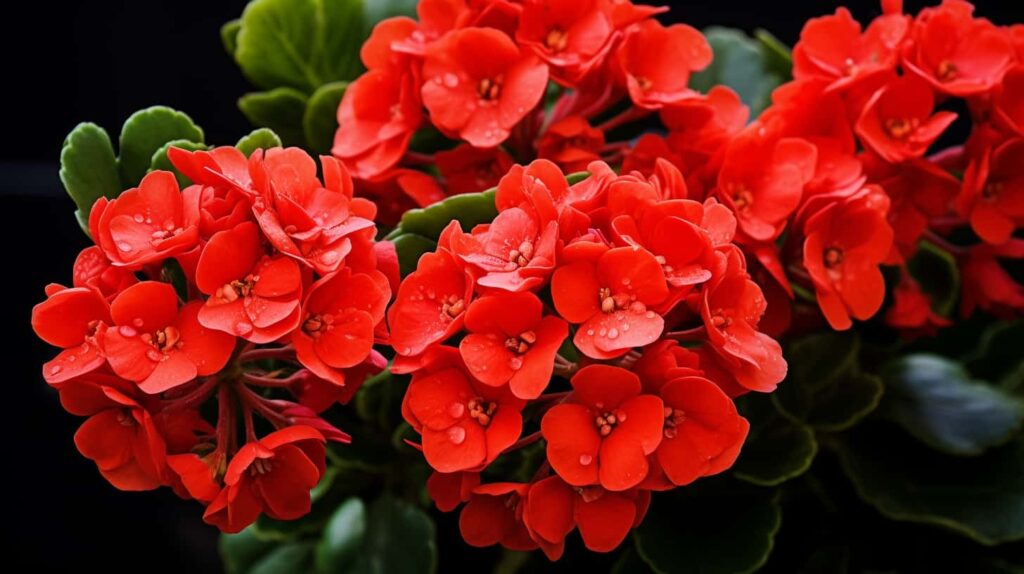
If you are growing your kalanchoe indoors, regular misting of the leaves can help increase humidity levels around the plant. This simple practice mimics the natural dew formation on their leaves and provides them with the moisture they need for optimal growth.
Nourishing Your Kalanchoe
Fertilizing Tips
To ensure the healthy growth of your kalanchoe plants, it’s important to provide them with the right nutrients. Here are some fertilizing tips to keep in mind:
-
Feed kalanchoe plants with a balanced, water-soluble fertilizer during the growing season. This type of fertilizer contains essential nutrients that will promote vigorous growth and vibrant blooms. Look for a fertilizer specifically formulated for flowering houseplants.
-
Dilute the fertilizer according to the package instructions and apply it every 2-4 weeks. It’s crucial not to overfeed your kalanchoe, as this can lead to salt buildup in the soil and damage the plant’s delicate roots. Follow the recommended dosage on the label to ensure you’re providing just the right amount of nutrients.
-
Avoid over-fertilization, as this can lead to salt buildup and damage the plant’s roots. While it may be tempting to give your kalanchoe extra fertilizer in hopes of boosting its growth, too much can actually harm the plant. Excess salts from over-fertilization can accumulate in the soil, causing root burn and inhibiting nutrient absorption.
-
During the dormant period, reduce or eliminate fertilization until new growth resumes. Kalanchoe plants enter a rest phase after blooming where they require less nutrients. During this time, it’s best to reduce or stop fertilizing altogether until you see signs of new growth emerging from the plant.
Watering Techniques
Proper watering is crucial for maintaining healthy kalanchoe plants. Here are some techniques to help you water your kalanchoes effectively:
-
Water kalanchoe thoroughly but allow the soil to dry out slightly between waterings. These succulent plants prefer well-draining soil and are susceptible to root rot if kept in overly moist conditions. Water the plant until water drains from the bottom of the pot, and then allow the top inch of soil to dry out before watering again.
-
Overwatering can lead to root rot, so it’s essential to avoid waterlogged conditions. Kalanchoes are native to arid regions and have adapted to survive in dry environments. They store water in their fleshy leaves and stems, making them more tolerant of drought than excessive moisture.
-
Use the “soak and dry” method by thoroughly watering the plant until water drains from the bottom of the pot. This technique ensures that water reaches all parts of the root system while allowing excess moisture to escape through drainage holes. After watering, wait for the soil to dry out before watering again.
-
Adjust watering frequency based on environmental conditions and the plant’s moisture needs. Factors such as temperature, humidity levels, and pot size can affect how quickly kalanchoe plants dry out between waterings. Monitor your plants closely and adjust your watering schedule accordingly to prevent under or over-watering.
Pruning and Maintenance
Pruning and maintaining your kalanchoe plants is essential to ensure their health and promote continuous blooming.
Deadheading Blooms
One important aspect of maintaining kalanchoe plants is deadheading, which involves removing spent blooms. By doing so, we encourage continuous blooming and redirect the plant’s energy towards new flower production instead of seed development.

To deadhead your kalanchoe plant, you’ll need a pair of clean pruning shears or scissors. Look for faded flowers and cut them off just above a leaf node or bud. This process not only improves the appearance of your plant but also stimulates further growth.
Proper disposal of the removed blooms is crucial to prevent potential disease transmission. Make sure to discard them in a designated area or compost bin rather than leaving them around your garden.
Pruning Guidelines
While pruning is generally not necessary for kalanchoe plants, it can be beneficial if you want to shape or control their growth. Here are some guidelines to follow when pruning your kalanchoe:
-
Use clean pruning shears to remove any leggy or damaged stems. Cut these back to a healthy node, which is where leaves emerge from the stem.
-
Timing is important. It’s best to prune after flowering or during early spring before new growth emerges.
-
Avoid excessive pruning as kalanchoe plants naturally have a compact and bushy growth habit.
By following these guidelines, you can maintain the overall shape and health of your kalanchoe without hindering its natural growth pattern.

Repotting Practices
Repotting your kalanchoe plant every 1-2 years or when it outgrows its current container is essential for its continued growth and health. Here are some practices to keep in mind when repotting:
-
Choose a slightly larger pot with drainage holes to accommodate the growing root system of your kalanchoe.
-
Gently remove the plant from its old pot, being careful not to damage the roots. Loosen the roots slightly before placing it in the new container with fresh potting mix.
-
After repotting, water your kalanchoe thoroughly to help it settle into its new environment.
Repotting provides your kalanchoe with fresh soil and room for its roots to expand, promoting healthy growth and preventing root-bound conditions.
Troubleshooting Common Problems
Wilting Issues Wilting is a common problem in kalanchoe plants and can be caused by both underwatering and overwatering. When the soil becomes too dry, the plant doesn’t receive enough water to support its growth, leading to wilting. On the other hand, overwatering can cause root rot, which prevents the roots from absorbing water properly, resulting in wilting as well.
To troubleshoot wilting issues in your kalanchoe plant, start by checking the moisture levels of the soil. Stick your finger about an inch into the soil and see if it feels dry or moist. If it’s dry, it’s a sign that you need to water your plant. However, if it feels consistently moist and wilting persists, there may be root rot present.
Inspect the roots of your kalanchoe plant for any signs of rot. Healthy roots should be firm and white or light brown in color. If you notice mushy or discolored roots, it’s an indication of root rot. In such cases, you’ll need to take appropriate action to save your plant.

To prevent wilting issues in kalanchoe plants, it’s important to establish proper watering practices. Water your plant thoroughly when the top inch of soil feels dry but avoid overwatering. Ensure that your pot has good drainage so that excess water can escape easily.
Soft or Damaged Leaves Soft or damaged leaves in kalanchoe plants can be a result of various factors including overwatering, pest infestation, or disease. Overwatering can lead to waterlogged conditions that soften the leaves and make them susceptible to damage.
If you notice softness or damage on the leaves of your kalanchoe plant, adjust your watering practices accordingly. Allow the soil to dry out between watering sessions and ensure that excess water drains away properly.
Inspect your plant for any signs of pests such as mealybugs or aphids. These insects can feed on the leaves, causing damage and making them soft. If you find any pests, treat your plant with appropriate insecticides or natural remedies to eliminate the infestation.
In some cases, soft or damaged leaves may be a sign of disease. Fungal or bacterial infections can cause leaf discoloration, spots, or wilting. If you suspect disease in your kalanchoe plant, isolate it from other plants and consult a gardening expert for guidance on treatment options.
To maintain overall plant health and appearance, it’s important to remove severely damaged leaves. Trim off any leaves that are extensively damaged or show signs of disease. This will help redirect the plant’s energy towards healthy growth.
Burned Foliage Excessive exposure to direct sunlight or high temperatures can lead to burned foliage in kalanchoe plants. The intense heat and light can scorch the leaves, causing them to turn brown or develop blackened areas.
If you notice burned foliage on your kalanchoe plant, it’s essential to provide shade or move the plant to a location with filtered light. Shielding it from direct sunlight during the hottest part of the day can prevent further leaf scorching.

Monitor temperature levels around your kalanchoe plant and ensure proper air circulation. High temperatures combined with stagnant air can exacerbate leaf burning. Consider placing a fan nearby to improve air movement and reduce heat stress on the plant.
When trimming off severely burned leaves, be careful not to remove too much healthy foliage. It’s important to strike a balance between removing damaged parts and preserving the overall structure of the plant.
Encouraging Vibrant Blooms
To ensure that your kalanchoe plants produce an abundance of colorful flowers, it’s essential to provide them with the right conditions and care. Here are some tips to help you encourage vibrant blooms:
Blooming Tips
-
Adequate Sunlight: Kalanchoe plants thrive in bright, indirect light. To promote optimal flower production, make sure they receive at least six hours of sunlight each day. Place them near a south-facing window if you’re growing them indoors or choose a spot in your garden that receives ample sunlight.
-
Consistent Care: Consistency is key. These plants prefer well-draining soil, so be careful not to overwater them. Allow the top inch of soil to dry out before watering again. Use a balanced fertilizer every two weeks during the growing season to support healthy growth and blooming.
-
Deadheading: Deadheading refers to the removal of spent flowers from the plant. Regularly deadhead your kalanchoe to encourage continuous blooming throughout the growing season. By removing faded flowers, you redirect energy towards producing new buds and blooms.
-
Proper Pruning: While not required for all kalanchoe species, pruning can help maintain compact growth and promote more abundant flowering. If your plant becomes leggy or unruly, trim back any excessive growth using clean pruning shears.
Sunlight Requirements
Understanding the sunlight requirements for your kalanchoe plants is crucial for their overall health and blooming success:
-
Bright Indirect Light: Kalanchoes prefer bright, indirect light rather than direct sunlight exposure for extended periods of time. Too much direct sun can lead to leaf burn or scorching.
-
Indoor Placement: When growing kalanchoes indoors, place them near a south-facing window where they can receive bright, indirect light. If your home doesn’t provide enough natural light, you can supplement it with artificial grow lights.
-
Outdoor Sun Exposure: Outdoor kalanchoe plants generally thrive in full sun or partial shade, depending on the specific species. It’s important to understand the sunlight requirements of your particular variety and find an appropriate location in your garden or patio.
-
Monitoring Sunburn: Keep an eye out for signs of sunburn on your kalanchoe plants, such as brown or yellow spots on the leaves. If you notice these symptoms, it may be an indication that your plant is receiving too much direct sunlight. Consider moving it to a spot with more shade or providing some protection during the hottest parts of the day.
Winter Care for Kalanchoe
During the winter months, it’s important to provide proper care for your kalanchoe plants to ensure their health and vitality.
Temperature Protection
Kalanchoe plants prefer moderate temperatures between 60-75°F (15-24°C), so it’s crucial to shield them from extreme cold or hot conditions. When the weather turns frosty, it’s best to bring your outdoor kalanchoe indoors or provide adequate insulation.
Exposure to freezing temperatures can damage the leaves and stems of your kalanchoe, leading to wilting or even death. To prevent this, place a protective covering over your outdoor plants or move them to a sheltered area such as a greenhouse or porch.
Indoor kalanchoe also requires attention. Avoid placing them near drafts or heating vents that can cause sudden temperature imbalances. These fluctuations in temperature can stress the plant and hinder its growth.
Maintaining stable temperatures is essential for promoting healthy growth in kalanchoe during the winter months. By providing a consistent environment within the preferred temperature range, you’ll help your plants thrive and avoid potential setbacks.
Light Adjustments
Proper lighting conditions are crucial for the well-being of your kalanchoe plants. It’s important to adjust their exposure based on their specific requirements and environmental factors.
If your plant is receiving too much direct sunlight, it may experience sunburn or leaf scorching. To prevent this, consider moving it to a location with filtered light or providing some shade using curtains or blinds. This will protect the leaves from excessive heat and ensure they remain vibrant and healthy.
On the other hand, insufficient light can result in leggy growth and reduced blooming in kalanchoe. If you notice that your plant is not getting enough brightness, consider moving it to a brighter spot or supplementing its light with artificial sources such as grow lights.
Regularly monitoring the lighting conditions for your kalanchoe is essential. Pay attention to the amount of natural light it receives throughout the day and make adjustments as needed. By providing optimal lighting conditions, you’ll encourage healthy growth and vibrant blooms in your kalanchoe plants.
Addressing Plant Health Issues
We need to be aware of potential plant health issues that may arise. Although kalanchoe plants are generally resilient and pest-resistant, they can still be affected by common houseplant pests and diseases.
Common Pests
While kalanchoe plants are known for their ability to resist pests, they may occasionally fall victim to some common houseplant invaders. Mealybugs, aphids, and spider mites are the most prevalent pests that can affect our beloved kalanchoe plants. To ensure the health of our plants, it is crucial to inspect them regularly for any signs of infestation.

Keep an eye out for sticky residue on the leaves or surrounding surfaces as this could indicate a mealybug problem. If you notice webbing or distorted leaves on your kalanchoe plant, it might be a sign of a spider mite infestation. Aphids can also leave behind a sticky residue and cause stunted growth in the plant.
If you spot any signs of pest activity on your kalanchoe plant, it is important to take immediate action. Treating infestations promptly can prevent further damage and protect the overall health of the plant. There are both organic and chemical insecticides available in the market that can help eliminate these pests effectively. However, always remember to carefully follow the instructions provided with the product when using any form of insecticide.
Maintaining a clean and healthy growing environment is another essential aspect of preventing pest issues in kalanchoe plants. Regularly remove any dead leaves or debris from around the plant as they can attract pests. Avoid overwatering your kalanchoe as excessive moisture can create an environment conducive to pest infestations.
Disease Prevention
Proper care and maintenance are crucial for preventing common diseases in kalanchoe plants. Overwatering is one of the primary causes of plant diseases, including root rot and fungal infections. To prevent these issues, it is important to avoid overwatering our kalanchoe plants. Allow the soil to dry out between waterings and ensure proper drainage in the pot.
Good air circulation around the plant is also essential for disease prevention. Adequate airflow helps to reduce humidity levels, which can discourage the development of foliar diseases such as powdery mildew or leaf spot. Placing the kalanchoe plant in a well-ventilated area can help promote healthy growth.

Regularly inspecting our kalanchoe plants is key to identifying any signs of disease early on. Keep an eye out for yellowing leaves, black spots, or any other unusual discoloration or deformities. If you notice any symptoms of disease, it is important to take appropriate action promptly.
Depending on the specific disease affecting your kalanchoe plant, treatment options may vary. For fungal infections, removing affected leaves and improving airflow around the plant can be beneficial. In some cases, applying a fungicide recommended for houseplants may be necessary.
Exploring Kalanchoe Varieties
Kalanchoe is a fascinating genus of plants that offers a wide range of varieties to explore. Each type has its own unique characteristics, making it an exciting adventure for plant enthusiasts. Let’s dive into the world of kalanchoe and discover some popular types and their distinct features.
Popular Types
-
Kalanchoe blossfeldiana: Known for its vibrant flowers in various colors, Kalanchoe blossfeldiana is one of the most popular species. With its eye-catching blooms, it adds a burst of color to any indoor or outdoor space.
-
Kalanchoe pinnata: Also called the “Mother of Thousands,” this variety stands out for its unique leaf propagation method. The edges of its leaves produce tiny plantlets, giving rise to numerous new plants over time. It’s truly a marvel to witness nature’s ability to create life from within itself.
-
Kalanchoe daigremontiana: Commonly known as the “Mother of Millions,” this species showcases another fascinating growth habit. Along the margins of its leaves, it produces numerous plantlets that eventually drop off and take root in the surrounding soil. This remarkable adaptation ensures the survival and proliferation of the species.
-
Kalanchoe tomentosa (Panda Plant) and Kalanchoe luciae (Flapjack Plant) are two other popular types worth mentioning. The Panda Plant features fuzzy leaves resembling panda ears, while the Flapjack Plant has thick paddle-shaped leaves with red-tinged edges. Both varieties offer unique aesthetics that make them stand out in any collection.
Unique Characteristics
-
Many kalanchoe species have thick, succulent leaves that store water, making them drought-tolerant plants. This adaptation allows them to survive in arid conditions where water may be scarce. Their ability to thrive with minimal water makes them an excellent choice for those who tend to forget frequent watering.
-
Some kalanchoe varieties produce clusters of small flowers, while others have larger, showy blooms. The diversity in flower size and color adds to the visual appeal of these plants. Whether you prefer delicate blossoms or bold, eye-catching flowers, there is a kalanchoe variety to suit your taste.
-
Certain species exhibit interesting growth habits that set them apart from other plants. For example, Kalanchoe pinnata propagates through its leaf margins, creating a unique spectacle of new life emerging from the mother plant. This process showcases nature’s remarkable ability to regenerate and multiply.
-
One of the remarkable features of kalanchoe plants is their adaptability to different growing conditions. They can thrive both indoors and outdoors, making them versatile choices for gardening enthusiasts. Whether you have limited space inside your home or a spacious garden outside, there is a kalanchoe variety that will flourish in your chosen environment.
Conclusion
And there you have it! We’ve explored the wonderful world of Kalanchoe plants, from discovering their beauty to cultivating and caring for them. We’ve learned how to propagate them, create ideal growing conditions, and nourish them to ensure vibrant blooms. We’ve also discussed pruning, troubleshooting common problems, and addressing plant health issues.
Through this journey, we’ve discovered that Kalanchoe plants are not only visually stunning but also resilient and easy to care for. They bring life and color to any space, whether it’s a sunny window sill or a garden bed. By following the tips and techniques we’ve shared, you can enjoy the beauty of Kalanchoe plants all year round.

So why not give it a try? Start your own Kalanchoe adventure today and experience the joy of nurturing these remarkable plants. Share your experiences with us and let’s continue this botanical journey together!
How Can I Apply Orchid Care Tips to Cultivate Vibrant Kalanchoe Plants?
Applying orchid care tips for blooms to cultivate vibrant kalanchoe plants involves ensuring proper watering, light, and temperature. Use a well-draining potting mix, water when the soil feels dry, and place the plant in a sunny spot. Also, consider fertilizing regularly and providing good air circulation for healthy growth.
Frequently Asked Questions
What is Kalanchoe?
Kalanchoe is a popular flowering succulent plant known for its vibrant and long-lasting blossoms. With its thick, fleshy leaves and stunning clusters of flowers, Kalanchoe adds beauty to any indoor or outdoor space.
How do I cultivate Kalanchoe Blossfeldiana?
To cultivate Kalanchoe Blossfeldiana, provide it with well-draining soil, bright but indirect sunlight, and regular watering. Maintain a temperature between 60-85°F (15-29°C) and feed it with a balanced fertilizer every two weeks during the growing season.
Can I propagate Kalanchoe plants?
Yes! Propagating Kalanchoe plants is relatively easy. You can propagate them through stem cuttings or by using leaf cuttings. Simply remove a healthy leaf or stem, allow it to callus for a few days, then place it in well-draining soil or water until roots develop.
How can I create ideal growing conditions for my Kalanchoe?
To create ideal growing conditions for your Kalanchoe, ensure it receives bright but indirect sunlight, as direct sun may scorch its leaves. Use well-draining soil to prevent root rot and water only when the top inch of soil feels dry. Avoid overwatering to maintain optimal growth.
Why is my Kalanchoe not blooming vibrantly?
If your Kalanchoe isn’t blooming vibrantly, it may be due to insufficient light or improper care. Ensure it receives enough bright but indirect sunlight and provide proper watering without overdoing it. Check if the plant needs fertilization or if pruning is necessary to encourage new blooms.
- About the Author
- Latest Posts
Meet Katherine, the creative enthusiast at ByRetreat who infuses her boundless passion for design into every remote workspace she crafts. With an innate sense of creativity and an eye for unconventional beauty, Katherine brings a unique and inspiring perspective to the team.
Katherine’s love for design is infectious, and her ability to think outside the box sets her apart. She believes that true artistry lies in embracing a variety of styles and mixing them harmoniously to create captivating spaces. By combining different textures, colors, and patterns, Katherine weaves a tapestry of creativity that breathes life into each remote workspace.
Plants
Ideal Hydrangea Spots: Best Place to Plant Hydrangeas
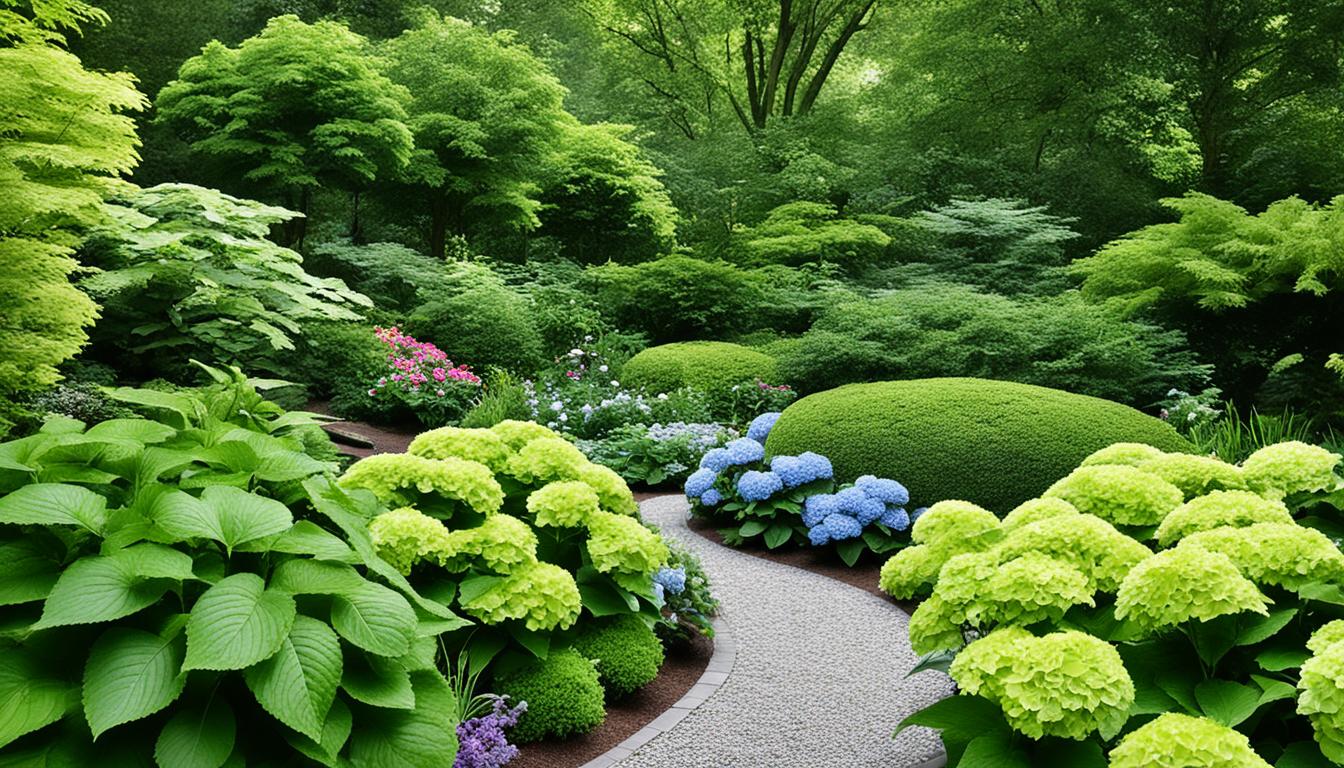
Did you know that the location where you plant your hydrangeas can have a significant impact on their growth and vibrancy? Finding the best place to plant hydrangeas is essential for optimal growth and to ensure that you get the most beautiful blooms.
In this guide, we will explore the different factors to consider when selecting the ideal spot for your hydrangeas. Whether you have a sunny garden or a shady corner, we’ll help you choose the right hydrangea varieties to thrive in various sun and shade conditions. By understanding their sunlight preferences and caring for them properly, you can enjoy vibrant and healthy hydrangea blooms year after year.
Key Takeaways:
- Choosing the right location is crucial for the growth and vibrancy of hydrangeas.
- Hydrangeas can thrive in different sunlight conditions, from full sun to partial shade.
- Consider the specific sunlight needs of different hydrangea varieties for optimal results.
- Proper care, including pruning, fertilizing, and watering, is essential for healthy blooms.
- By following our planting guide and care tips, you can transform your garden with stunning hydrangea displays.
Hydrangeas for Part Shade: Give Us Some Sunblock Please
When it comes to creating the perfect environment for hydrangeas, finding the right balance of sun and shade is key. While some hydrangea varieties thrive in full sun, others prefer a location with partial shade, where they can benefit from the morning sun and enjoy relief from the scorching afternoon rays. These hydrangeas are like beachgoers who know the importance of sunblock, seeking a little shade to protect themselves from the intense heat.
In the family of hydrangeas, there are several popular cultivars that are well-suited for part shade conditions. These varieties have the ability to produce stunning blooms when provided with a combination of filtered light and a few hours of full sun. Among them are the beloved Endless Summer® Hydrangea series, which includes BloomStruck®, Endless Summer®, Blushing Bride®, and Twist-n-Shout®.
Another great choice for morning sun and afternoon shade is the Annabelle Hydrangea, which is known for its spectacular large white flowers. And let’s not forget the many bigleaf hydrangea cultivars that can handle part shade and reward you with their vibrant blossoms.
Here are a few remarkable hydrangea varieties that thrive in part shade:
| Hydrangea Variety | Light Requirements |
|---|---|
| Endless Summer® series (BloomStruck®, Endless Summer®, Blushing Bride®, Twist-n-Shout®) | Morning sun, afternoon shade |
| Annabelle Hydrangea | Morning sun, afternoon shade |
| Bigleaf hydrangea cultivars | Morning sun, afternoon shade |
These hydrangeas have adapted to thrive in part shade by enjoying the gentle morning sun and being sheltered from the intense afternoon heat. This combination of light conditions allows them to produce their enchanting blooms and add a touch of elegance to any garden or landscape.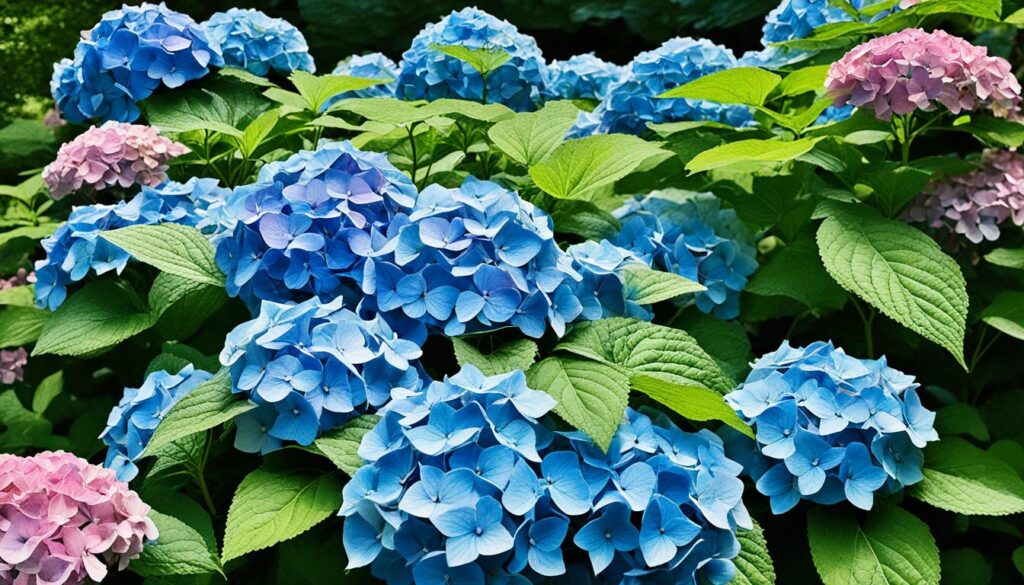
So, if you have a garden or yard with a mix of sunlight and shade, don’t worry! There are plenty of beautiful hydrangeas that will thrive in this environment. Just give them some sunblock (in the form of morning sun) and watch as their blooms light up your space with their breathtaking beauty.
Hydrangeas for Full Sun: We Like It Sunny
While most hydrangeas prefer some shade, there are certain varieties that can thrive in full sun. If your garden gets plenty of sunlight, don’t worry! There are hydrangeas that will flourish in these conditions and reward you with beautiful blooms.
Panicle Hydrangeas
Panicle hydrangeas, known for their cone-shaped flower clusters, are excellent choices for full sun exposure. They can tolerate the direct heat and intense sunlight, making them perfect for sunny spots in your garden. Some popular panicle hydrangeas include:
- Fire Light®
- Limelight
- Pinky Winky®
- Strawberry Sundae®
- Vanilla Strawberry®
Dwarf Varieties
If you have limited space or prefer compact hydrangeas, consider the Let’s Dance® and Cityline® series. These dwarf varieties are perfect for both full sun and part sun environments. They offer the beauty of hydrangeas in a smaller package without compromising on vibrant blooms.
Smooth Hydrangeas
Smooth hydrangeas are another type that can handle full or part sun conditions. These varieties are known for their large rounded flower heads and are a great choice for a sunny garden. Consider the following smooth hydrangeas:
- Incrediball®
- Invincibelle® Ruby
With these hydrangeas, you can enjoy the beauty and charm of these flowering plants even in full sun areas. Just make sure to provide them with proper care and maintenance, including regular watering and occasional fertilization.
Overall, including hydrangeas that thrive in full sun can add a splash of color and vibrancy to your garden. Whether you choose panicle hydrangeas, dwarf varieties, or smooth hydrangeas, these sun-loving beauties will brighten up any sunny corner of your outdoor space.
Growing Hydrangeas in Different Sun and Shade Conditions
When it comes to growing hydrangeas, understanding their sunlight requirements is essential for their success. While many hydrangea varieties thrive in partial shade, oakleaf hydrangeas are known for their adaptability to different sun and shade conditions.
In the northern parts of the United States, oakleaf hydrangeas can tolerate full sun. However, in warmer and southern climates, they prefer some afternoon shade to protect them from excessive heat and sun exposure. This makes them an excellent choice for those looking to plant hydrangeas in regions with varying temperature and sunlight conditions.
What makes oakleaf hydrangeas unique is their ability to also tolerate full shade. This makes them ideal for areas of the garden that receive little to no direct sunlight. Whether it’s a densely shaded corner or underneath taller trees, oakleaf hydrangeas can thrive and add beauty to areas that are typically challenging for other hydrangea varieties.
It’s important to note that while oakleaf hydrangeas are the most adaptable, other hydrangea varieties have specific sunlight needs. When selecting the location for planting, it’s crucial to consider the specific requirements of each hydrangea type to ensure optimal growth and vigor.
By carefully assessing the sunlight conditions in your garden and selecting the appropriate hydrangea varieties, you can create a diverse and captivating display of hydrangeas that thrive in different sun and shade conditions.
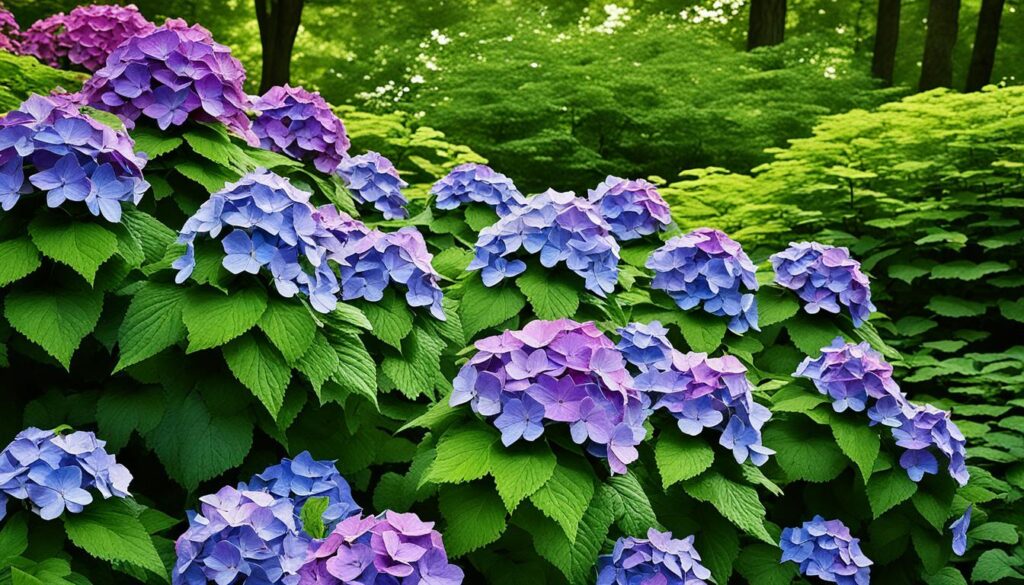
Pruning and Caring for Hydrangeas
Proper pruning and care are essential for the health and vitality of hydrangeas. By implementing appropriate pruning techniques and providing the necessary care, gardeners can ensure the longevity and abundant blooming of their hydrangea plants. Here are some important tips to consider:
Understanding Pruning Methods
When pruning hydrangeas, it’s crucial to understand whether the plant blooms on old wood or new wood. This knowledge will help gardeners avoid accidentally cutting off next season’s flowers.
Tip: Prune hydrangeas that bloom on old wood immediately after flowering. This allows for new growth and development of flower buds for next year. On the other hand, hydrangeas that bloom on new wood can be pruned during late winter or early spring before new growth begins.
Optimal Soil Conditions
Hydrangeas thrive in well-drained soil that is rich in organic matter. A mixture of compost and native soil is ideal for providing the necessary nutrients and moisture retention.
Fertilizing for Healthy Blooms
To promote healthy blooming, it’s recommended to fertilize hydrangeas with a slow-release fertilizer that is high in phosphorus. Phosphorus is essential for promoting flower production and overall plant vitality.
Preventing Leaf Scorch
Hydrangeas are susceptible to leaf scorch, especially during hot and dry periods. To prevent leaf scorch, it’s important to provide hydrangeas with extra water and ensure they have adequate moisture in the soil.

Summary of Pruning and Care Tips
| Pruning Method | Soil Conditions | Fertilizing | Preventing Leaf Scorch |
|---|---|---|---|
| Prune hydrangeas that bloom on old wood immediately after flowering | Well-drained soil with organic compost | Use slow-release fertilizer high in phosphorus | Provide extra water during hot and dry periods |
By following these pruning and care tips, hydrangea enthusiasts can enjoy lush, vibrant blooms year after year. With proper maintenance, these stunning plants will continue to beautify gardens and landscapes.
Conclusion
Planting hydrangeas in the best location and providing proper care and maintenance are key to achieving beautiful and vibrant blooms. By selecting the right spot that balances sun and shade, ensuring well-drained soil, and following recommended pruning and watering practices, gardeners can enjoy the full potential of their hydrangea plants. With the right planting and care, hydrangeas can transform any garden into a colorful and inviting space.FAQ
What is the best place to plant hydrangeas?
What are the best types of hydrangeas for morning sun and afternoon shade?
Can hydrangeas grow in full sun?
Which hydrangea varieties are best for full shade?
How should I prune and care for hydrangeas?
Are there any tips for planting and caring for hydrangeas?
- About the Author
- Latest Posts
Meet Katherine, the creative enthusiast at ByRetreat who infuses her boundless passion for design into every remote workspace she crafts. With an innate sense of creativity and an eye for unconventional beauty, Katherine brings a unique and inspiring perspective to the team.
Katherine’s love for design is infectious, and her ability to think outside the box sets her apart. She believes that true artistry lies in embracing a variety of styles and mixing them harmoniously to create captivating spaces. By combining different textures, colors, and patterns, Katherine weaves a tapestry of creativity that breathes life into each remote workspace.
Plants
Grow Zucchini Successfully: Best Way & Tips

Did you know that zucchini plants are susceptible to squash vine borers, a pest that can quickly kill the plants by cutting off the flow of water? The impact of these destructive borers can be devastating to your zucchini harvest. However, by following the best practices and tips for growing zucchini, you can ensure successful cultivation and enjoy a bountiful harvest.
Whether you are a seasoned gardener or a novice looking to try your hand at gardening, this article will provide you with valuable insights on the best way to grow zucchini and tips for successful cultivation. From avoiding squash vine borers to proper planting techniques, soil requirements, spacing, and pollination, we will cover everything you need to know to grow zucchini successfully.
Key Takeaways:
- Delay planting zucchini until mid-July or use row covers to prevent squash vine borers
- Start zucchini from seeds or seedlings and choose the right time to plant
- Provide well-draining soil enriched with organic material for optimal growth
- Space zucchini plants at least 3-4 feet apart and consider trellising for better air circulation
- Ensure proper pollination for optimal fruit production and harvest zucchini at any size
Planting and Germination
Zucchini, a popular summer squash variety, can be easily grown from seeds or seedlings. While starting zucchini indoors is an option, direct sowing in the ground is the preferred and most common method of planting zucchini seeds. Here’s a step-by-step guide to planting zucchini seeds and ensuring successful germination:
1. Prepare the Soil
Before starting zucchini indoors or sowing the seeds outside, it’s crucial to have well-prepared soil. Ensure the soil is loose, rich in organic matter, and drains well. Incorporating compost or aged manure can greatly improve the soil’s fertility. Measure the soil temperature and wait until it consistently reaches above 55 degrees Fahrenheit for successful germination.
2. Planting Zucchini Seeds
When the soil is ready, plant the zucchini seeds about an inch deep into the soil. Space the seeds at least 3 feet apart to allow ample room for growth. Lightly mist the top of the soil with water to ensure proper moisture levels for the germination of zucchini. Take care not to overwater the seeds, as it can lead to rotting.
Pro Tip: For those who prefer starting zucchini indoors, plant the seeds in peat pots or biodegradable seed starting trays about 2-3 weeks before the last expected frost. Transplant the seedlings outdoors once the soil temperature is suitable.
3. Germination and Thinning
The germination period of zucchini seeds typically ranges from 5 to 10 days. During this time, it’s important to keep the soil consistently moist but not waterlogged. Once the seedlings reach a height of around 3 inches and develop 2 sets of true leaves, it’s time to thin them out. Starting zucchini indoors often leads to more seedlings, so removing the weaker ones will allow the strongest ones to flourish.
4. Timing is Key
For optimal growth, it’s crucial to plant zucchini at the right time. Zucchini thrives in warm soil, so direct sowing should take place in the second half of May when the risk of frost has passed and the soil has warmed up. This timing ensures that the young seedlings will not succumb to cold temperatures.
“Direct sowing zucchini seeds is the most practical and successful method for home gardeners. The plants quickly establish themselves and produce abundant healthy foliage and fruit.” – Gardening Expert, Jessica Washington
By following these planting zucchini seeds and germination guidelines, you can give your zucchini plants a head start in their growth journey. Whether you choose to start the seeds indoors or directly sow them in the ground, with proper care and attention, you’ll soon be rewarded with healthy zucchini plants ready to produce an abundance of delicious squash.
| Benefits of Direct Sowing Zucchini Seeds | Benefits of Starting Zucchini Indoors |
|---|---|
| 1. Simplifies the planting process | 1. Provides an earlier start to the growing season |
| 2. Minimizes transplant shock | 2. Offers more control over seedling development |
| 3. Allows seeds to germinate and grow in their natural environment | 3. Enables better protection against adverse weather conditions |
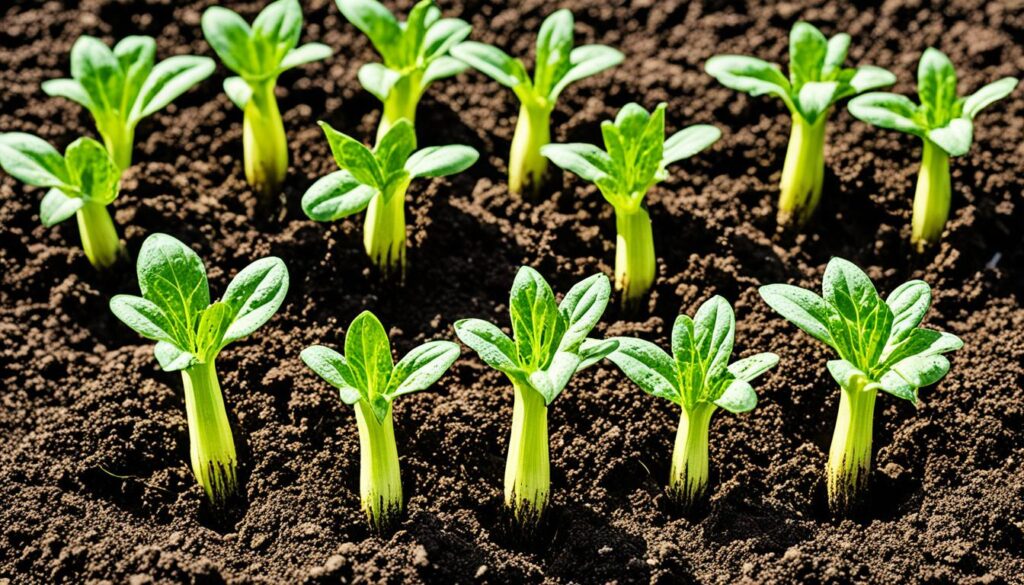
Soil and Location Requirements
Zucchini plants require specific soil and an ideal location to thrive and produce a bountiful harvest. Providing the right conditions for your zucchinis will ensure their health and productivity.
Choosing the Best Soil
Zucchini plants prefer organically rich, fertile, and well-draining soil. When planting in raised beds or containers, it is essential to select a well-draining potting soil. To enhance the soil’s fertility, add organic material or compost at the time of planting. This will help create a nutrient-rich environment for the zucchini plants to thrive.
If you are planting zucchinis directly in the ground, it is crucial to amend the soil with rich organic material or compost. This will improve the soil’s texture and provide the necessary nutrients for the plants to grow strong and healthy. Additionally, good drainage is essential for zucchini plants, as they prefer moist but not waterlogged conditions.
Choosing the Ideal Location
When selecting a location for your zucchini plants, it is important to consider their sunlight requirements. Zucchinis thrive in areas that receive full sun for at least 6-8 hours a day. Choose an area in your garden that is not shaded by buildings or trees, as this can hinder their growth and development.
Furthermore, it is important to note that zucchinis should not be planted in soil where other cucurbits (such as pumpkins or cucumbers) were grown in the past 1-2 years. This practice helps prevent the spread of diseases and pests that may affect the zucchini plants.
By providing the right soil conditions and selecting an ideal location with ample sunlight, you will create an optimal environment for your zucchini plants to flourish and produce an abundant crop.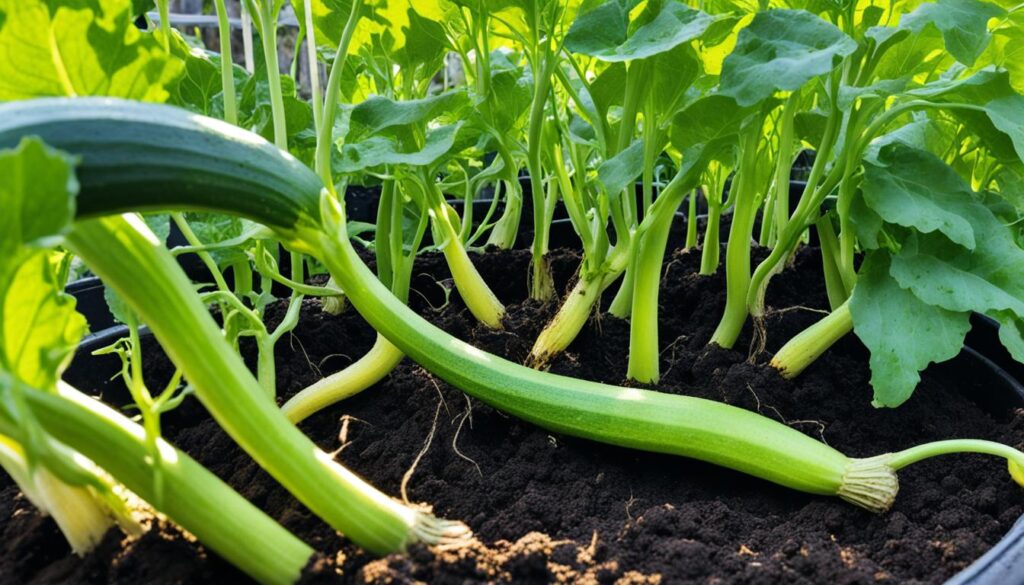
“Zucchini plants prefer organically rich, fertile, and well-draining soil. Provide the right conditions to help your zucchini plants thrive and produce a bountiful harvest.”
Spacing and Trellising
Proper spacing and trellising techniques are essential for the successful growth and development of zucchini plants.
Spacing Zucchini Plants
When it comes to zucchini plant spacing, giving enough room for each plant is crucial for optimal growth. It is recommended to space zucchini plants at least 3-4 feet apart, whether planting them in hills or rows.
For planting in hills, a general guideline is to plant 3 zucchinis per hill in a triangle pattern. Ensure the hills are also spaced 3-4 feet apart to provide enough space for the plants to receive nutrients and expand their root systems.
If growing zucchinis in containers, create a mound in the center of the container and plant three zucchinis around it. This arrangement allows for adequate airflow and efficient use of space while providing the plants with the necessary growing area.
Trellising Zucchini
Another option for maximizing space and aiding in pest management is trellising zucchini plants. By training them to grow vertically along a trellis or stakes, you can create a visually appealing and space-saving garden.
When trellising zucchini, ensure that the trellis or stakes are sturdy enough to support the weight of the plants and their fruit. As the zucchinis grow, gently guide the vines and tendrils toward the trellis, securing them with twist ties or plant clips.
The benefits of trellising zucchini include improved air circulation, which helps prevent disease, easier harvesting, and reduced pest damage since the plants are elevated off the ground.
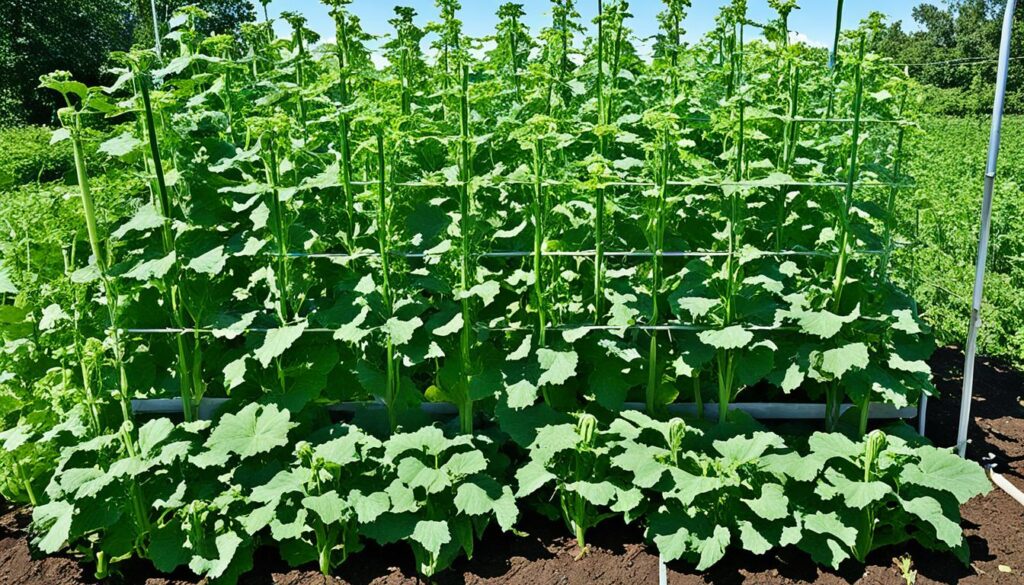
Implementing proper spacing and trellising techniques ultimately promotes healthier zucchini plants, increased productivity, and efficient use of garden space.
Pollination and Fruit Production
Zucchini plants rely on pollination for fruit production. These plants have separate male and female flowers, and the transfer of pollen from the male to the female flowers is crucial for the development of zucchini fruits. To ensure successful pollination, it’s important to understand how pollinators play a role in this process. 
Pollinators such as bees, butterflies, and other insects are attracted to the bright yellow flowers of zucchini plants. To maximize their presence in your garden, consider planting companion flowers like borage, catmint, dill, or dahlias nearby. These flowers will help attract pollinators, increasing the chances of successful pollination.
In some cases, there may be a lack of natural pollination due to factors such as weather conditions or a limited number of pollinators in the area. In such situations, manual pollination can be done to ensure fruit production. This process involves using a small brush or cotton swab to transfer pollen from the male flowers to the female flowers. By gently brushing the inside of the male flower and then transferring the pollen to the stigma of the female flower, you can help facilitate pollination.
Tip: To identify male and female flowers, look for the presence of a small zucchini-shaped swelling at the base of the female flower. Male flowers, on the other hand, do not have this swelling.
Proper pollination is essential for optimal fruit development. It ensures that the female flowers receive the necessary pollen for fertilization, leading to the formation of healthy zucchini fruits. Be sure to monitor the progress of your zucchini plants and check for signs of fruits developing from the female flowers.
When it comes to harvesting zucchini, you can do so at any size. However, larger zucchinis may have more developed seeds and a denser texture, which might not be desirable for certain recipes. In such cases, it is recommended to remove the seeds before consumption. This can be done by slicing the zucchini lengthwise and scooping out the seeds with a spoon.
Conclusion
Successful zucchini cultivation requires attention to several key factors, including avoiding squash vine borers, following proper planting techniques, providing the right soil and location, spacing plants correctly, and ensuring proper pollination. By implementing these tips and techniques, gardeners can enjoy a bountiful harvest of zucchinis that can be incorporated into a wide range of dishes.
The best way to grow zucchini is to start by carefully timing the planting, ensuring that soil temperatures are consistently above 55 degrees Fahrenheit. This warm soil temperature provides an ideal environment for germination and growth. Additionally, choosing a well-lit area with full sun for at least 6 hours a day will help zucchinis thrive.
When it comes to soil and location requirements, zucchini plants prefer organically rich and well-draining soil. Amend the soil with compost or rich organic material to promote healthy growth. Adequate spacing is essential for proper plant development, with a recommended distance of 3-4 feet between plants. Trellising zucchini plants can also save space and improve airflow.
Finally, ensuring proper pollination is crucial for maximizing fruit production. Planting companion flowers near zucchinis can attract beneficial pollinators, and manual pollination can be done to supplement natural pollination. Harvesting can be done at any size, but larger zucchinis may require seed removal before consumption.FAQ
When is the best time to plant zucchini?
How can I prevent squash vine borers from killing my zucchini plants?
What type of soil do zucchini plants prefer?
How should I space my zucchini plants?
Do zucchini plants require manual pollination?
Can I grow zucchini vertically?
- About the Author
- Latest Posts
Meet Katherine, the creative enthusiast at ByRetreat who infuses her boundless passion for design into every remote workspace she crafts. With an innate sense of creativity and an eye for unconventional beauty, Katherine brings a unique and inspiring perspective to the team.
Katherine’s love for design is infectious, and her ability to think outside the box sets her apart. She believes that true artistry lies in embracing a variety of styles and mixing them harmoniously to create captivating spaces. By combining different textures, colors, and patterns, Katherine weaves a tapestry of creativity that breathes life into each remote workspace.
Plants
Best Conditions for Ginger Root Growth Explained
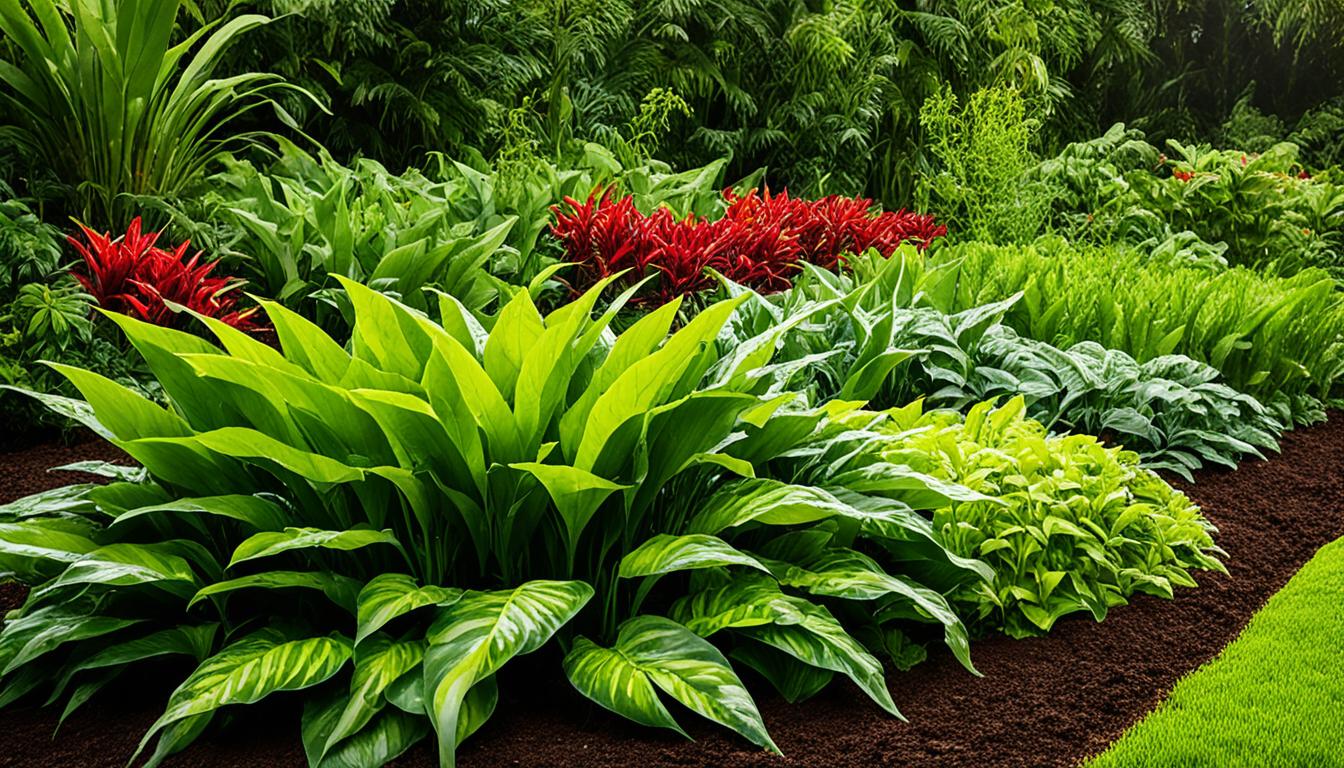
Ginger, known for its unique flavor and medicinal properties, is a versatile root used in everything from cooking to herbal remedies. But did you know that the success of ginger cultivation depends heavily on the conditions in which it is grown? Creating the best conditions for ginger root growth is essential to yield a bountiful harvest and vibrant plants.
From temperature to soil quality and moisture levels, each aspect plays a crucial role in ginger’s growth and well-being. By understanding the optimal conditions, gardeners and enthusiasts can replicate ginger’s tropical habitat and cultivate healthy plants with exceptional flavor and aroma.
In this article, we will explore the optimal conditions necessary for ginger root growth, offering insights and techniques to help you grow ginger successfully. Whether you’re an experienced gardener or a beginner with a green thumb, this guide will provide valuable knowledge to enhance your ginger cultivation.
Key Takeaways:
- Ginger root growth requires specific conditions to thrive.
- Temperature, soil quality, moisture, and shade are essential factors.
- Best practices include using organic matter, maintaining proper drainage, and providing dappled shade.
- Ginger can be grown in containers, hoop houses, or greenhouses.
- Pre-sprouting ginger indoors can maximize the growing season.
Optimal Soil Conditions for Ginger Root Growth
Ginger plants require optimal soil conditions to thrive and produce healthy root growth. By providing the right environment, gardeners can ensure that their ginger plants receive the necessary nutrients and support for robust growth. Here are some essential factors to consider when creating optimal soil conditions for ginger root growth:
- Rich in Organic Matter: Ginger prefers soil that is rich in organic matter, which provides essential nutrients and promotes healthy root development. Adding lots of compost to the ground or using a peat and wood bark-based soilless medium mixed with sand in containers can help create a fertile growing medium.
- Organic Fertilizers and Worm Castings: Supplementing the soil with organic fertilizers and worm castings can further enhance the nutrient content, ensuring that ginger plants have access to the necessary elements for their growth. These natural amendments provide a slow-release source of nutrients, promoting long-term plant health.
- Good Drainage: It is crucial to ensure good drainage in the soil to prevent waterlogging, as standing water can negatively affect ginger growth. To improve drainage, incorporating coarse sand or perlite into the soil can help create a well-draining environment for the roots.
- pH Levels: Maintaining the right pH levels is essential for optimal ginger growth. Ginger plants prefer slightly acidic soil, with pH levels between 5.5 and 6.5. Testing the soil’s pH and making appropriate adjustments using organic soil amendments or sulfur can help create the ideal conditions for ginger plants.
By creating soil conditions that are rich in organic matter, well-draining, and with the right pH levels, gardeners can provide the optimal environment for ginger root growth. The next section will explore the ideal temperature range for ginger plants and the impact it has on their growth and development.
Soil Conditions for Ginger Root Growth
| Soil Condition | Description |
|---|---|
| Rich in organic matter | Ginger prefers soil that is rich in organic matter, such as compost or a peat and wood bark-based soilless medium mixed with sand. |
| Organic fertilizers and worm castings | Adding organic fertilizers and worm castings can provide essential nutrients for ginger plants. |
| Good drainage | Ensuring good drainage in the soil is crucial to prevent waterlogging, which can negatively affect ginger growth. |
| pH levels between 5.5 and 6.5 | Maintaining slightly acidic soil with pH levels between 5.5 and 6.5 is ideal for ginger plants. |

Ideal Temperature Range for Ginger Root Growth
Ginger is a tropical plant that thrives in warm temperatures, making the ideal temperature range a crucial factor for its successful growth. The ideal temperature range for ginger root growth is 70° to 90°F (21° to 32°C). This range provides the optimal conditions for ginger plants to thrive and produce healthy rhizomes.
When growing ginger, it is important to consider the nighttime temperatures as well. It is recommended to plant ginger when nighttime temperatures are consistently above 55°F (13°C). Cooler temperatures can slow down the growth of ginger plants or even cause damage to them, hindering their development.
In regions with colder climates, it may be challenging to maintain these ideal temperatures for ginger growth. However, there are ways to overcome this obstacle and still grow ginger successfully. Growing ginger indoors in a controlled environment, such as a greenhouse or conservatory, can provide the necessary warmth for ginger plants to thrive.

Importance of Moisture for Ginger Root Growth
Ginger is a moisture-loving plant that requires consistent watering to thrive and produce healthy and flavorful roots. Proper moisture management is essential for ginger root growth.
The soil should be kept evenly moist, providing enough water to meet the plant’s needs without overwatering or allowing the soil to dry out completely. Overwatering can lead to waterlogged conditions, which can suffocate the roots and promote the development of root rot. Conversely, letting the soil dry out completely can cause stress to the plant and hinder its growth.
Watering frequency may vary depending on factors such as the climate, humidity levels, and container size. In general, it is advisable to water ginger plants whenever the top inch of soil feels slightly dry. This allows for proper hydration without risking waterlogging.
Proper irrigation techniques and good drainage are crucial for maintaining the ideal moisture levels for ginger root growth. In containers, ensure that there are drainage holes to prevent water from pooling at the bottom. For in-ground planting, selecting a well-draining soil or amending the soil with organic matter can improve moisture balance.
Expert Tip:
When watering ginger plants, it’s important to give them a deep soak, allowing the water to penetrate the root zone. However, avoid overhead watering as it can lead to the development of fungal diseases. Instead, direct the water towards the base of the plant or use a drip irrigation system to ensure precise watering.
By maintaining the right moisture levels through proper watering techniques and good drainage, gardeners can provide the optimal conditions for ginger root growth, ensuring healthy plants and a bountiful harvest.

Moisture Guidelines for Ginger Root Growth
| Moisture Level | Signs | Recommended Action |
|---|---|---|
| Soggy or Waterlogged | Wilting, yellowing leaves; foul odor; root rot | Improve drainage by adding organic matter; reduce watering frequency |
| Too Dry | Wilting, dry soil; slow growth | Increase watering frequency; mulch around plants to retain moisture |
| Evenly Moist | Healthy foliage; steady growth | Continue regular watering; monitor moisture levels |
Benefits of Dappled Shade for Ginger Root Growth
Ginger plants thrive in dappled shade, which provides them with a balanced environment for optimal growth. The benefits of dappled shade include protection from direct sunlight, prevention of soil overheating and excessive drying, and maintenance of suitable moisture levels.
Planting ginger under the shelter of taller crops or using shade cloth can create the perfect conditions for ginger root growth. The dappled shade allows the plants to receive filtered sunlight, which is essential for photosynthesis while reducing the risk of sunburn or heat stress.
“Dappled shade is like a natural sunscreen for ginger plants, shielding them from the harsh rays of the sun and maintaining a cool, comfortable environment.”
By providing dappled shade, you can create an ideal microclimate for ginger root growth. The shade helps regulate soil temperatures, preventing it from becoming too hot and drying out too quickly. This is particularly important for ginger, as it prefers consistently moist soil.
Moreover, dappled shade helps to reduce water evaporation, allowing the roots to stay moist for longer periods. This helps the ginger plants establish a strong root system and absorb essential nutrients from the soil, promoting healthy growth and development.
When setting up dappled shade for your ginger plants, it is important to strike a balance. While providing shade, ensure that there is still enough light penetration for proper photosynthesis. Ginger plants need adequate sunlight to produce energy for growth, but too much direct sunlight can be detrimental.
Consider planting ginger in an area where it receives morning sun and partial afternoon shade. This allows the plants to benefit from the warmth and light of the morning sun while being shielded from the intense heat of the afternoon sun.
To summarize, dappled shade provides numerous benefits for ginger root growth, including protection from direct sunlight, prevention of soil overheating and excessive drying, and maintenance of suitable moisture levels. By implementing dappled shade techniques, you can create an ideal environment for ginger plants to thrive and produce a bountiful harvest.
Pros and Cons of Dappled Shade for Ginger Root Growth
| Benefits of Dappled Shade | Considerations for Dappled Shade |
|---|---|
| Protection from direct sunlight | Ensure there is still enough light for photosynthesis |
| Prevents soil overheating | Find a balance between shade and sunlight |
| Reduces soil drying out | Choose an area with morning sun and partial afternoon shade |
| Maintains suitable moisture levels |

Recommended Planting Techniques for Ginger Root Growth
When it comes to cultivating ginger, selecting the right planting technique is crucial for successful root growth. Whether using whole rhizomes or cut pieces, understanding the proper methods will optimize your ginger harvest. Here are some recommended planting techniques:
1. Using Whole Rhizomes
Planting ginger with whole rhizomes is a straightforward technique that yields excellent results. Look for healthy, plump rhizomes with well-developed buds or eyes. These larger rhizomes tend to grow quicker and produce more robust plants.
To plant whole rhizomes:
- Prepare the soil by loosening it with a garden fork or tiller.
- Dig a trench that is about 6 to 8 inches deep.
- Place the rhizomes in the trench with the eyes facing upwards.
- Cover the rhizomes with soil, ensuring they are well-buried but not too deep.
- Water gently to settle the soil.
2. Using Cut Rhizome Pieces
If you have limited planting material or want to maximize your ginger yield, using cut rhizome pieces is a viable option. When cutting the rhizomes, ensure each piece has at least one bud or eye.
To plant cut rhizome pieces:
- Prepare the soil or select a suitable container with good drainage.
- Fill the container with a well-draining potting mix or amend the soil with organic matter.
- Place the cut rhizome pieces in the soil or container, burying them about 1 to 2 inches deep.
- Water thoroughly to encourage root establishment.
Note: Make sure there is adequate room for the rhizomes to grow when planting in containers. This will prevent overcrowding and promote healthier plant development.
3. Pre-sprouting Indoors
For gardeners who wish to extend the growing season or gain a head start on ginger production, pre-sprouting indoors is an effective technique. This method involves placing the rhizomes in a tray with moist compost or paper towel to encourage early sprouting.
To pre-sprout ginger indoors:
- Select healthy rhizomes with visible eyes.
- Fill a tray with moist compost or lay paper towels on a flat surface.
- Place the rhizomes on the compost or paper towels, positioning them with the eyes facing upwards.
- Maintain the moisture level by misting regularly.
- Keep the tray or paper towels in a warm location with indirect sunlight.
- Once sprouts have developed, carefully transplant them into individual containers or directly into the ground.
Pre-sprouting allows for an earlier harvest and ensures that the ginger plants have a strong start before being exposed to outdoor conditions.
Remember, ginger responds well to a warm and humid environment, so providing the optimal conditions during the planting process will contribute to its overall growth and development.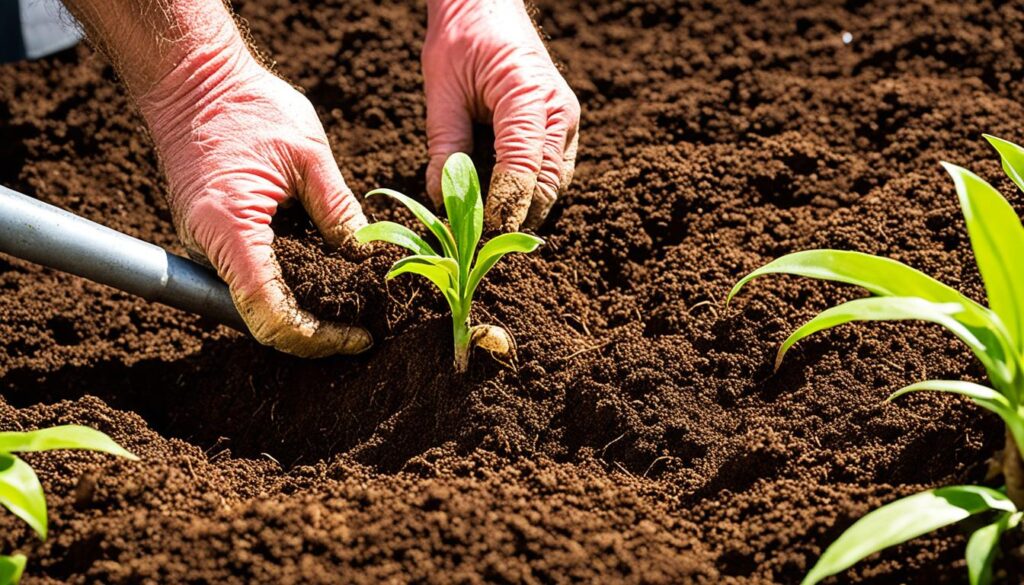
| Planting Technique | Advantages | Disadvantages |
|---|---|---|
| Using Whole Rhizomes | – Quicker growth – Larger harvests |
– Requires more planting material – Limited control over spacing |
| Using Cut Rhizome Pieces | – Maximizes planting material – Allows for precise spacing |
– Slower initial growth – Smaller rhizome yields |
| Pre-sprouting Indoors | – Provides an early start – Enhances germination rates |
– Requires additional indoor space – Requires regular misting |
Care Tips for Ginger Root Growth
Proper care is crucial for the successful growth of ginger roots. By providing the right conditions, you can ensure healthy plants and a bountiful harvest. Here are some essential care tips for ginger root growth:
1. Warmth: Ginger plants thrive in warm environments, so it’s important to provide them with a suitable temperature. During the summer, whether you are growing ginger outdoors or indoors, it’s beneficial to place the plants in a warm and humid area.
2. Humidity: Humidity is another important factor for ginger root growth. If you are growing ginger indoors, placing the plant near a bright windowsill can help simulate the ideal conditions. Additionally, occasional misting with water can create a humid environment that mimics the plant’s natural habitat.
3. Moisture: Adequate moisture levels are essential for ginger plants. It’s important to water the plants regularly, ensuring that the soil is evenly moist. However, be cautious not to overwater, as excessive moisture can lead to root rot. To promote proper drainage, use pots with drainage holes and allow the soil to dry out slightly between waterings.
4. Mulching: Applying a layer of mulch around ginger plants can serve multiple benefits. Mulching helps to conserve moisture in the soil, reducing the frequency of watering required. Additionally, it helps to suppress weed growth, keeping the area around the ginger plants clean and tidy.
Ginger plants require a combination of warmth, humidity, moisture, and proper drainage to thrive. By following these care tips, you can create optimal conditions for ginger root growth and enjoy a successful harvest.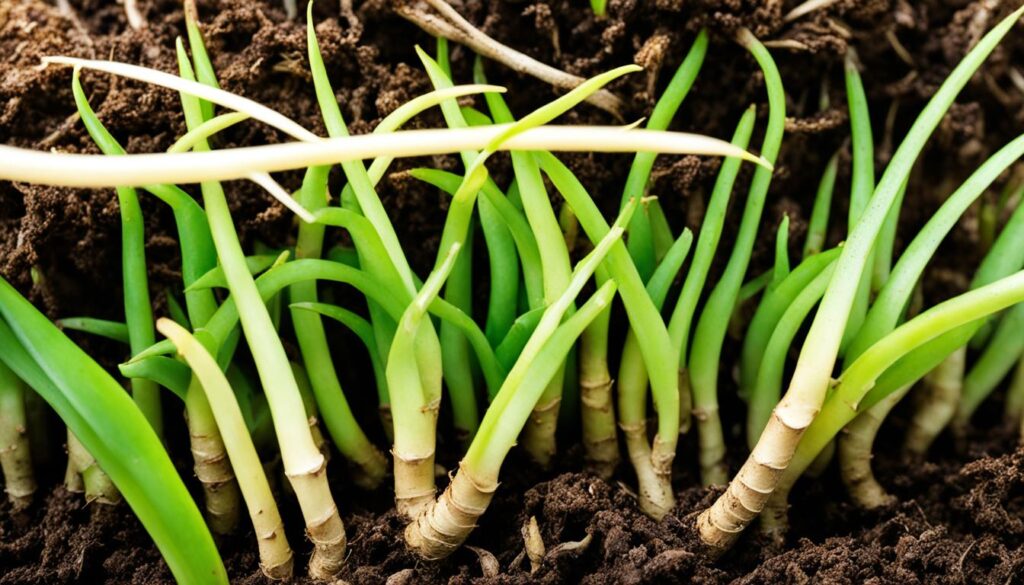
| Care Tips for Ginger Root Growth | Benefits |
|---|---|
| Provide warmth | Creates a favorable environment for ginger plants |
| Maintain humidity | Simulates the plant’s natural habitat and supports growth |
| Ensure proper moisture | Prevents drying out or waterlogging |
| Use mulch | Conserves moisture and suppresses weed growth |
Conclusion
Growing ginger successfully requires replicating its tropical natural habitat as closely as possible. Providing optimal soil conditions, the right temperature range, adequate moisture, and dappled shade is crucial. By following these best practices, gardeners can ensure the best conditions for ginger root growth and enjoy a bountiful harvest.
When it comes to planting ginger, there are two main methods: using whole rhizomes or cutting them into pieces and pre-sprouting indoors for an earlier harvest. Both approaches can be effective, but it’s important to pay careful attention to watering and drainage. Ginger cannot tolerate standing water or drying out completely, so finding the right balance is key.
Remember that ginger thrives in warm temperatures, ideally ranging from 70° to 90°F (21° to 32°C). Additionally, ginger plants appreciate some dappled shade, as it protects them from direct sunlight and helps prevent the soil from drying out too quickly. Creating these optimal conditions will give your ginger the best chance to grow and thrive.
So whether you’re growing ginger in the ground, in containers, or in a greenhouse, make sure to provide it with the right environment. By replicating its tropical natural habitat as closely as possible and paying attention to its specific needs, you can enjoy a bountiful harvest of delicious and aromatic ginger roots.
FAQ
What are the best conditions for ginger root growth?
What are the optimal soil conditions for ginger root growth?
What is the ideal temperature range for ginger root growth?
How important is moisture for ginger root growth?
What are the benefits of dappled shade for ginger root growth?
What are the recommended planting techniques for ginger root growth?
What are the care tips for ginger root growth?
- About the Author
- Latest Posts
Meet Katherine, the creative enthusiast at ByRetreat who infuses her boundless passion for design into every remote workspace she crafts. With an innate sense of creativity and an eye for unconventional beauty, Katherine brings a unique and inspiring perspective to the team.
Katherine’s love for design is infectious, and her ability to think outside the box sets her apart. She believes that true artistry lies in embracing a variety of styles and mixing them harmoniously to create captivating spaces. By combining different textures, colors, and patterns, Katherine weaves a tapestry of creativity that breathes life into each remote workspace.
-

 Vetted5 days ago
Vetted5 days ago15 Best Printers of 2024: Top Picks and Expert Reviews
-

 Vetted1 week ago
Vetted1 week ago15 Best Tile Sealers for Long-Lasting Protection and Shine
-

 Vetted2 weeks ago
Vetted2 weeks ago15 Best Smelling Floor Cleaners That Will Leave Your Home Fresh and Inviting
-

 Vetted1 week ago
Vetted1 week ago14 Best Power Scrubbers for Showers That Will Transform Your Cleaning Routine
-

 Vetted2 days ago
Vetted2 days ago15 Best Evergreen Plants for Shade Gardens: A Complete Guide
-

 Vetted2 days ago
Vetted2 days ago15 Best LED Dimmer Switches With No Flicker: Ultimate Guide for a Flicker-Free Lighting Experience
-

 Mardi Gras Decoration4 days ago
Mardi Gras Decoration4 days agoWhat Do the Symbols of Mardi Gras Mean?
-

 Appliances1 week ago
Appliances1 week ago5 Best Energy-Efficient Stainless Steel Fridges 2023






















